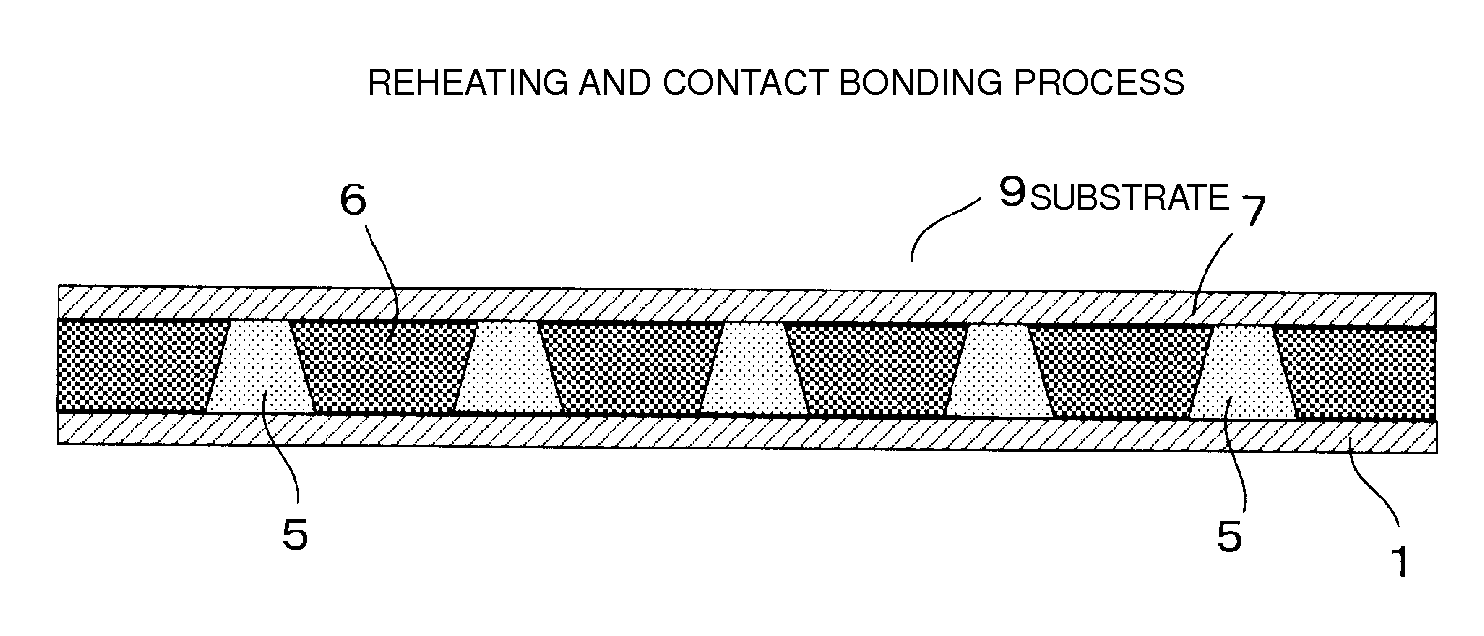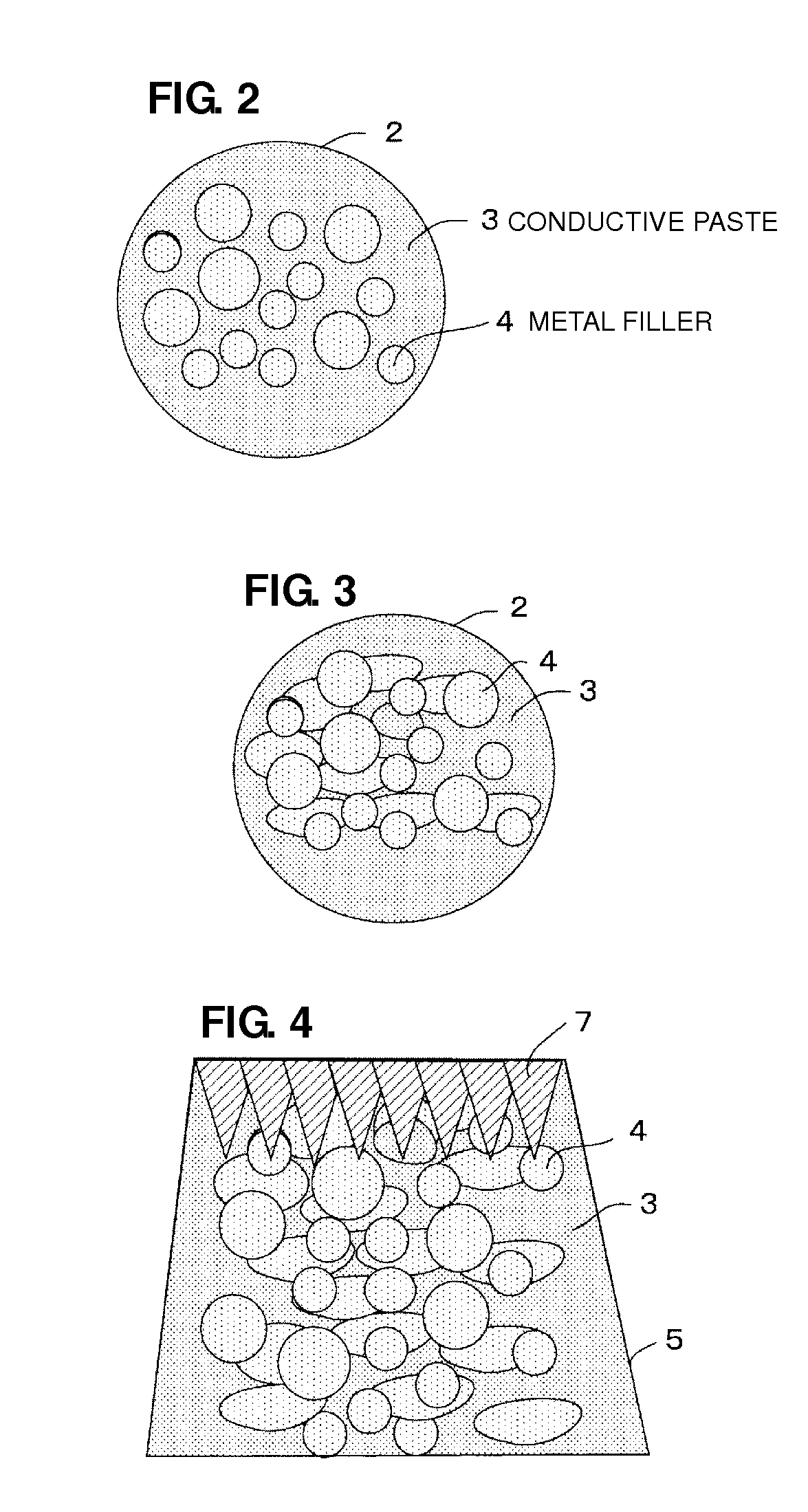Method for manufacturing substrate
- Summary
- Abstract
- Description
- Claims
- Application Information
AI Technical Summary
Benefits of technology
Problems solved by technology
Method used
Image
Examples
first preferred embodiment
[0031]First, a first preferred embodiment of the present invention will be described with reference to FIGS. 1A to 4.
[0032]FIGS. 1A-1D show a method for manufacturing a substrate according to the present preferred embodiment in process sequence.
[0033]In a first bump formation step (FIG. 1A), one metal foil 1 is prepared as a carrier contact-bonded to one principal surface of a thermosetting insulating resin layer formed from an epoxy resin or other suitable material as will be described later, and bumps 2 of a conductive paste including metal fillers which can be melted at a temperature lower than the curing temperature (around 180° C.) of the insulating resin layer are formed on the surface of the metal foil 1. FIG. 2 shows a transverse section of the bump 2 in a bump formation process (before heating), and particles of metal fillers 4 are scattered substantially homogeneously in a conductive paste 3 in the bump 2 before heating.
[0034]The metal foil 1 may be fundamentally various t...
second preferred embodiment
[0047]Next, a second preferred embodiment of the present invention will be described with reference to FIGS. 5A and 5B.
[0048]In the case of the present preferred embodiment, the metal columns 5 integrally connected to the metal foil 1 in FIG. 1B are preferably formed on, for example, a transfer plate (not shown) according to the bump formation step and metal column formation in the first preferred embodiment.
[0049]Next, an insulating resin layer 10 with components built therein is prepared in a press-fitting process in FIG. 5A in place of the press-fitting process in FIG. 1C. The insulating resin layer 10 is formed, for example, by burying one or more electronic components 11 such as coils, capacitors, transistors, and ICs in the uncured resin layer 6 according to the first preferred embodiment, and a wiring pattern of a metal foil 12 corresponding to the metal foil 7 in FIG. 1C is contact-bonded to the lower surface of the insulating resin layer 10. The electronic components 11 hav...
modification example
[0054]Incidentally, the metal columns 5 preferably have a larger area of the base on the metal foil 1 side, and have contact with the external electrodes 11a in a straddling and protruding manner. FIG. 6 shows the metal columns 5 in contact with external the electrodes 11a in a straddling and protruding manner through the press-fitting process.
[0055]More specifically, in the case of providing connections through conventional vias, processing down to the bottom has to be carried out without damaging external electrodes. Thus, via processing itself is difficult, and it is thus difficult to control the processing conditions. In addition, the variation in component height, the variation in mounting, etc., cause a failure to control the thickness of the insulating resin layer 10 on the external electrodes 11a, thereby causing defective processing.
[0056]Furthermore, in the case of the metal columns 5 in FIGS. 5A and 5B, the projected area of the metal column 5 viewed from above is smaller...
PUM
| Property | Measurement | Unit |
|---|---|---|
| Current | aaaaa | aaaaa |
| Current | aaaaa | aaaaa |
| Luminous intensity | aaaaa | aaaaa |
Abstract
Description
Claims
Application Information
 Login to View More
Login to View More - R&D
- Intellectual Property
- Life Sciences
- Materials
- Tech Scout
- Unparalleled Data Quality
- Higher Quality Content
- 60% Fewer Hallucinations
Browse by: Latest US Patents, China's latest patents, Technical Efficacy Thesaurus, Application Domain, Technology Topic, Popular Technical Reports.
© 2025 PatSnap. All rights reserved.Legal|Privacy policy|Modern Slavery Act Transparency Statement|Sitemap|About US| Contact US: help@patsnap.com



